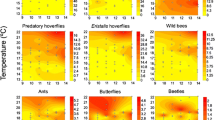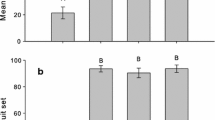Abstract
One of the most immediate responses to disturbance is a change in population density. Change in plant population density may have an effect on visiting and pollinating insects which may influence both fecundity and gene flow. The management regime of the grasslands has a major influence on the density and distribution of plant species. Changes in the management in the river valley grasslands of the Drentse Aa from intensive grassland production to mowing once a year without the applications of fertilizers has caused large changes in the density and distribution of Rhinanthus angustifolius. Initially the density rose than fall becoming very abundant locally (de Hullu et al., 1985). This study considers the effect of population density on visitation pollination and gene exchange.
Access this chapter
Tax calculation will be finalised at checkout
Purchases are for personal use only
Preview
Unable to display preview. Download preview PDF.
Similar content being viewed by others
References
Bierzychudek, P. (1981). Pollinator limitation of plant reproductive effort. Am. Nat. 117: 838–840.
Borg, S.J. ter (1985). Population biology and habitat relations of some hemiparasitic Scrophulariaceae. In: White, J. (Ed.). The population structure of vegetation, pp 463–487. Dr. W. Junk Publishers, Dordrecht.
Brantjes, N.B.M. (1976). Bloemengeur bij maneschijn, oecologisch onderzoek met nachtvlinderbloemen. Ph.D. thesis, University of Nijmegen, the Netherlands.
Davis, M.A. (1981). The effect of pollinators, predators and energy constraints on the floral ecology and evolution of Trillium erectum. Oecologia (Berlin) 48: 400–406.
Donovan, B.J. (1980). Interactions between native and introduced bees in new Zealand. J. of Ecol. 3: 104–116.
Eickwort, G.C. & Ginsberg, H.S. (1980). Foraging and mating behavior in Apoidea. Ann. Rev. Entomol. 25: 421–446.
Fossel, A. (1974). Die Bienenweide der Ostalpen, dargestelt am Beispiel des steirischen Ennstales. Mitt, naturwiss. Ver. Steiermark 104: 87–118.
Foosel, A. (1977). Raffinierter Nektarraub beim Klappertopf (Rhinanthus sp.). Bienenvater 1: 1–4.
Ginsberg, H.S. (1983). Foraging ecology of bees in an old field. Ecology 64: 165–175.
Heinrich, B. (1979a). Resource heterogeneity and patterns of movement in foraging bumblebees. Oecologia (Berlin) 40: 235–245.
Heinrich, B. (1979b). Bumblebee economics. Harvard University Press, Cambridge, Massachusetts and London, England.
Heinrich, B & Raven, P.H. (1972). Energetics and pollination ecology. Science N.Y. 176: 597–602.
Holmes, F.O. (1964). The distribution of honey bees and bumblebees on nectar-secreting plants. Amer. Bee J. 104: 12–13.
Hullu, E. de, Brouwer, T. & Borg, S.J. ter (1985). Analysis of the demography of Rhinanthus angustifolius populations. Acta Bot. Neerl. 34:5–22.
Inouye, D.W. (1978). Resource partitioning in bumblebees: experimental studies of foraging behavior. Ecology 59: 672–678.
Inouye, D.W. (1980). The terminology of floral larcency. Ecology 61: 1251–1253.
Inouye, D.W. (1983). The ecology of nectar robbing. In: Bentley, B. & Elias, T. (Eds.). The biology of nectaries, pp 153–173. Columbia University Press, New York.
Kendall, D.A. & Smith, B.D. (1975). The pollinating efficiency of honeybee and bumblebee visits to field bean flowers. J. appl. Ecol. 12: 709–717.
Kendall, D.A. & Smith, B.D. (1976). The pollinating efficiency of honeybee and bumblebee visits to flowers of the runner bean Phaseolus coccineus L. J. appl. Ecol. 13: 749–752.
Kwak, M.M. (1977). Pollination ecology of five hemiparasitic, large flowered Rhinanthoideae with special reference to the pollination behaviour of nectar-thieving, short-tongued bumblebees. Acta Bot. Neerl. 26: 97–107.
Kwak, M.M. (1979a). Effects of bumblebee visits on the seed set of Pedicularis, Rhinanthus and Melampyrum (Scrophulariaceae) in the Netherlands. Acta Bot. Neerl. 28: 177–195.
Kwak, M.M. (1979b). Maintenance of species integrity in sympatrically occurring Rhinanthus minor and R. serotinus in the Netherlands. Oecologia (Berlin) 41: 1–9.
Kwak, M.M. (1980). The pollination value of honeybees to the bumblebee plant Rhinanthus. Acta Bot. Neerl. 29: 597–603.
Kwak, M.M. & Jennersten, O. (1986). The significance of pollination time and frequency and of purity of pollen loads for seed set in Rhinanthus angustifolius (Scrophulariaceae) andViscaria vulgaris (Caryophyllaceae). Oecologia (Berlin) 70:502–507.
Levin, D.A. & Kersten, H.W. (1969). The dependence of bee-mediated pollen and gene dispersal upon plant density. Evolution 23:560–571.
Levin, D.A. (1974): Gene flow in seed plants. Evol. Biol. 7: 139–220.
Pyke, G.H. (1978). Optimal foraging: movement patterns of bumblebees between inflorescences. Theor. Pop. Biol. 13: 72–98.
Pyke, G.H., Pullion, H.R. & Charnov, E.L. (1977). Optimal foraging: a selective review of theory and tests. Quart. Rev. Biol. 52: 137–154.
Schaffer, W.M. & Schaffer, M.V. (1979). The adaptive significance of variations in reproductive habit in the Agavaceae II: Pollinator foraging behavior and selection for increased reproductive expenditure. Ecology 60: 1051–1069.
Schaffer, W.M., Jensen, D.B., Hobbs, D.E., Gurevith, J., Todd, J.R. & Schaffer, M.V. (1979). Competition, foraging energetics and the cost of sociality in three species of bees. Ecology 60: 976–987.
Schaffer, W.M., Zek, D.W., Buchmann, S.L., Kleinhaus, S., Schaffer, M.V. & Antrim, J. (1983). Competition for nectar between introduced honeybees and native North American bees and ants. Ecology: 64 564–577.
Schmitt, J. (1983). Flowering plant density and pollinator visitation in Senecio. Oecologia (Berlin) 60: 97–102.
Silander, J.A. (1978). Density-dependent control of reproductive success in Cassia biflora. Biotropica 10: 292–296.
Stephenson, A.G. (1982). When does outcrossing occur in a mass-flowering plant? Evolution 36: 762–767,
Thomson, J.D. (1981). Spatial and temporal components of resource assessment by flower-feeding insects. J. Anim. Ecol. 50: 49–59.
Thomson, J.D. & Plowright, R.C. (1980). Pollen carryover, nectar rewards and pollinator behavior with special reference toDiervilla lonicera. Oecologia (Berlin) 46: 68–74.
Visscher, P.K. & Seeley, T.D. (1982). Foraging strategy of honeybee colonies in a temporate deciduous forest. Ecology 63: 1790–1801.
Waddington, K.D. (1980). Flight patterns of foraging bees related to density of artificial flowers and distribution of nectar. Oecologia (Berlin) 44: 199–204.
Waddington, K.D. (1981). Factors influencing pollen flow in bumblebee-pollinated Delphinium virescens. Oikos 37: 153–159.
Waddington, K.D. (1983). Pollen flow and optimal outcrossing distance. Amer. Natur. 122: 147–151.
Willmer, P.G. (1980). The effect of insect visitors on nectar constituents in temperate plants. Oecologia (Berlin) 47: 270–277.
Willson, M.F. & Price, P.W. (1979). The evolution of inflorescence size in Asclepias (Asclepiadaceae). Evolution 31: 495–511.
Willson, M.F. & Ratcke, B.J. (1974). Adaptive design of the floral display in Asclepias syriaca L. Amer. Midi. Nat. 92: 47–57.
Willson, M.F., Miller, L.J. & Ratcke, B.J. (1979). Floral display in Phlox and Geranium: adaptive aspects. Evolution 33: 52–63.
Zimmerman, M. (1980). Reproduction in Polemonium: competition for pollinators. Ecology 61: 497–501.
Zimmerman, M. (1981). Optimal foraging, plant density, and the marginal value theorem. Oecologia (Berlin) 49: 148–153.
Zimmerman, M. (1982): The effect of nectar production on neighborhood size. Oecologia (Berlin) 52: 104–108.
Zimmerman, M. (1983). Plant reproduction and optimal foraging: experimental nectar manipulations inDelphinium nelsonii. Oikos 41: 57–63.
Editor information
Editors and Affiliations
Rights and permissions
Copyright information
© 1987 Dr W. Junk Publishers, Dordrecht
About this chapter
Cite this chapter
Kwak, M.M. (1987). Pollination and pollen flow disturbed by honeybees in bumblebee-pollinated Rhinanthus populations?. In: Van Andel, J., Bakker, J.P., Snaydon, R.W. (eds) Disturbance in Grasslands. Geobotany, vol 10. Springer, Dordrecht. https://doi.org/10.1007/978-94-009-4055-0_19
Download citation
DOI: https://doi.org/10.1007/978-94-009-4055-0_19
Publisher Name: Springer, Dordrecht
Print ISBN: 978-94-010-8300-3
Online ISBN: 978-94-009-4055-0
eBook Packages: Springer Book Archive




